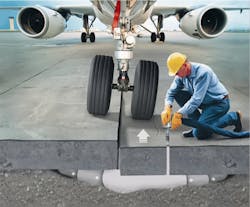Runway Reliability – Stable Soils Make the Difference
Faulted joints on airport runways, taxiways, and aprons aren’t necessarily anyone’s fault. Sometimes it is simply a matter of time and moisture and the slow, steady movement of soils beneath the surface. For busy airfields with no time or budget for full depth repair and replacement, URETEK and its industry-leading 486 Star® polymer are the winning combination that keeps critical airport assets smooth and stable for years to come.
“The strengths of URETEK Deep Injection® (UDI) are most easily appreciated on airport projects”, says Mark Richardson, Vice President of Sales and Marketing at URETEK. “UDI performs just as well in other pavement preservation applications, but the strict specifications, tight schedules, and need for rapid mobilization are never more critical than when we take on an airport project.”
Since 1989, the company has specialized in precision high-density polyurethane foam (HDPF) injection, all based around a unique, two-part polymer with industry-leading hydrophobic properties.
“As our industry has grown, more and more people have become aware of the clear choice between traditional ‘rip and replace’ pavement repair and HDPF injection. But when the discussion becomes a comparison between different types of HDPF injection, it really all comes down to the material used,” added Richardson.
URETEK 486 Star® polymer is a two-component, high-density, expanding thermoset polyurethane system. It was developed to be the ideal solution for under-sealing, void filling, lifting of settled pavement, stabilizing and stiffening weak soils, and for encapsulating and sealing buried infrastructure. URETEK 486 Star® is environmentally inert, non-toxic, and resists underground water erosion or weakening due to its inherent hydro-insensitivity.
According to Richardson, “Our polymer forms properly in the presence of water and doesn’t break down over time when exposed to moisture. What this means to our clients is that they can rely on the specifications we quote for our product, and the results we warranty for UDI. When we stabilize the soils beneath a runway or taxiway, our clients can count on a long future without another soil problem.”
Key features of URETEK’s 486 Star® polymer are largely credited with the product’s success. For concrete pavements, the small hole diameter required results in far less overall slab weakening. Furthermore, the product is water resistant and creates a dimensionally stable structural polymer even when injected into wet soils. The rapid curing of URETEK’s polymer provides precise control over the repair process, and the highly controllable 486 Star® material allows for precision adjustments to 1/8”. Finally, with a tw0-year warranty against future settlement, airport administrators can rely on UDI to solve problems today and well into the long-term future.
Despite all the advantages that come from using a superior HDPF polymer, URETEK relies heavily on the experience and expertise of its crews. With more than 85,000 successful projects completed and over 50,000 miles of pavement rehabilitated to date, the repeated success of UDI is largely made possible by the accumulated knowledge of URETEK’s management and crew leaders.
URETEK’s representatives and operations teams bring decades of practical engineering, geotechnical, chemical, construction, and pavement experience to every airport project. According to Richardson, “Our engineering group consults with our field operations personnel on every airport job, designing specific approaches for more complex circumstances.” Richardson adds that as an authorized DOD contractor (UFC 3-270-01), URETEK takes special pride in the flawless execution of airport projects.
Widely referenced throughout the industry, UDI involves the injection of structural polymer into base and subgrade soils to increase their load bearing capacity. Where required, a precise lift can be applied to the pavement system to return it to grade. URETEK’s 486 Star® polymer quickly cures into a strong, dimensionally stable, and water-resistant geo-material that provides years of reliable service.
For airport administrators, UDI eliminates the disruption of airfield operations when performed at off-peak hours and involves a tiny footprint compared to other repair options. With no excavation required, work crews can quickly access the project work area and typically complete an airport project in a matter of days, not weeks.
Indeed, past airport customers have reported that the significantly shorter time frame required to complete UDI has been a major plus when choosing URETEK. During a typical airport UDI project, work crews dismantle and remove work zones as soon as they finish each work shift, usually scheduled during overnight, off-peak hours. As a point of pride, URETEK crews routine leave the work zone cleaner than they found it. With minimal scheduling disruptions for the travelling public, UDI represents a logical choice for airports intent on maintaining normal operations during repair projects, airside and landside.
URETEK serves its clients from its corporate headquarters near Houston, Texas, and from operational centers located across the United States. The extensive URETEK network enables the company to respond quickly when emergency situations arise.
URETEK offers the most successful soil stabilization and pavement rehabilitation record in the world, with proven performance in diverse conditions. Every airport project leverages this experience and results in the quickest, most professional, and longest-lasting solution in the industry.
“The URETEK team includes industry experts whose ongoing research and development have led to many of the innovations in polymer soil stabilization and pavement lifting used throughout the industry today,” says Richardson. “It’s an honor to be able to tell this story.”
